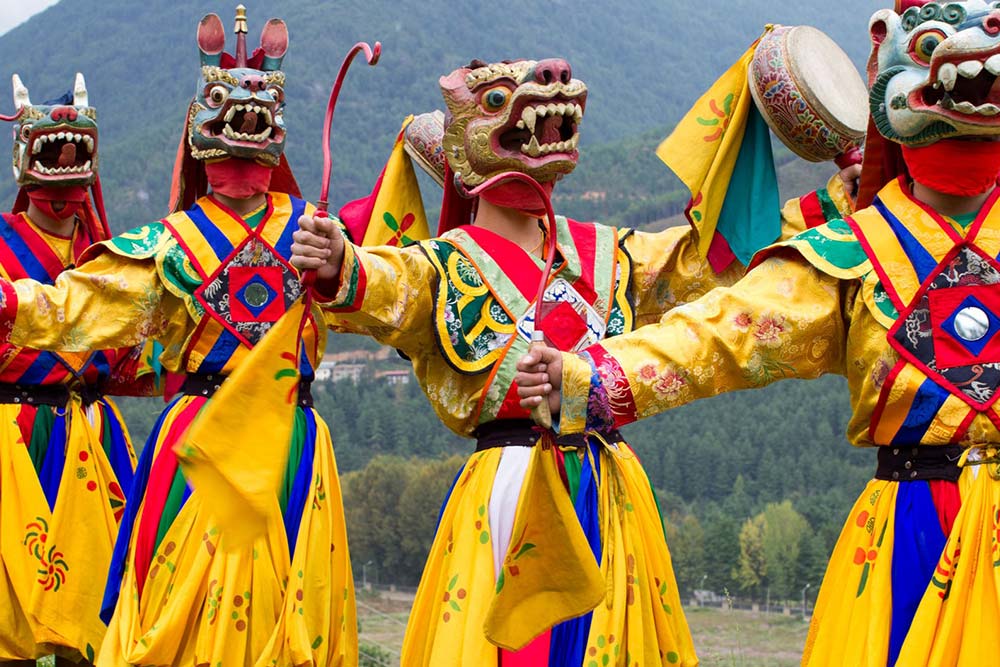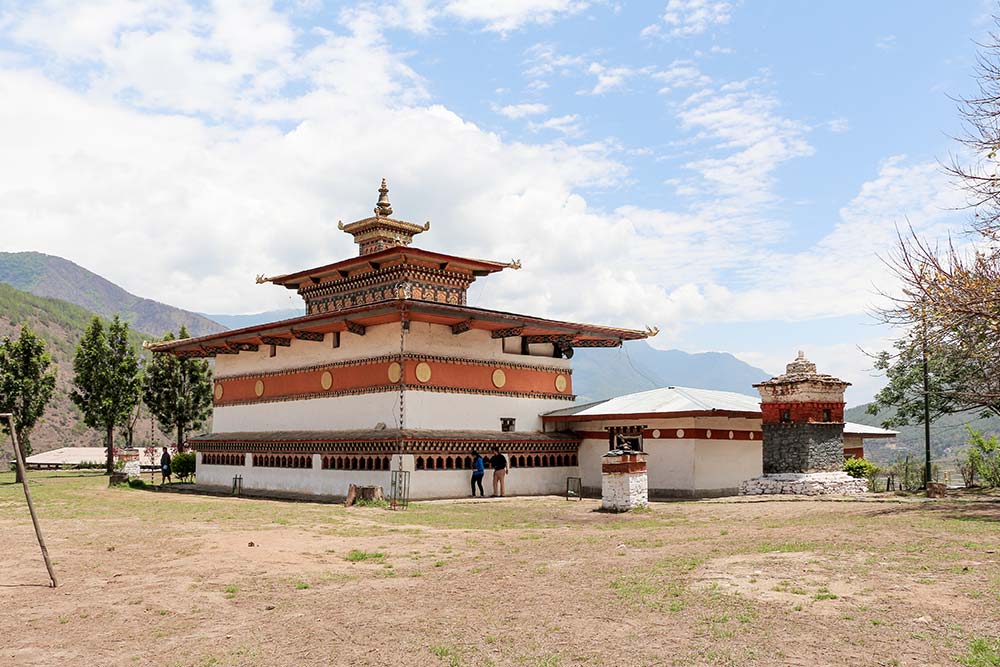- Home
- Travel Style
- Culture & Heritage
- Bhutan Culture and Wildlife
Tour Itinerary
12 Days / 11 Nights
Day 1
Arrive Paro - Drive to Thimphu (55 kms/2 hrs)
Upon your arrival in Paro this morning, you will be met by our representative at the airport. After a warm welcome, drive to Thimphu, the modern capital town of Bhutan. Upon arrival check in at your hotel and freshen up.
Later this afternoon visit National Memorial Chorten, the stupa built in the memory of Bhutan's Third King who is popularly regarded as Father of modern Bhutan. The paintings and statues inside this monument provide a deep insight into Buddhist philosophy.
[Thimphu altitude: 2350M]
Day 2
Day in Thimphu
Today, enjoy discovering the serene and beautiful city of Thimphu, world’s only capital city without traffic lights. Visit Tashichho Dzong, the beautiful medieval fortress which houses most of the Government offices and the King’s throne room.
Then visit the Folk Heritage and National Textile Museum and Bhutanese traditional handmade paper factory. Also visit the National Library, which houses a wonderful collection of Buddhist text and manuscripts.
After lunch visit Handicrafts Emporium which offer a wide assortment of beautifully handcrafted products, including the splendid Thangkas paintings and exquisitely woven textiles for which Bhutan is famous. Also visit Arts & Crafts School, famous for traditional thangkha paintings. Here you will see, students at work producing intricate design on cloth.
[Thimphu altitude: 2350M]
Day 3
Thimphu to Punakha (75 kms/2 Hrs)
This morning embark on a short drive to Punakha, the erstwhile winter capital of Bhutan.
Enjoy the scenic drive through Dochu-la pass (3080m) that heralds the most enchanting views of Bhutan. Take a photo stop and enjoy some light refreshments whilst enjoying breathtaking Himalayan views.
Continue drive to Punakha and upon arrival check in at your hotel and freshen up.
This afternoon visit Punakha Dzong dating back to the 17th century. In the evening, enjoy a stroll in the local market.
[Punakha altitude: 1350M]Day 4
Day in Punakha
After a leisurely breakfast take a short hike through fields of chilies, cabbages and rice along river banks to Khamsum Yulley Namgyel Chorten, from where you see beautiful views of Mo-Chu River and villages below. Built in the 1990s, Bhutanese craftsmen including carpenters, painters, and sculptors consulted holy scriptures rather than engineering manuals, to construct this 4-storey temple.
Later in the afternoon hike up to Chimi Lhakhang (Temple of the Divine Madman), situated on a hillock in the centre of the valley, dedicated to Lama Drukpa Kenley, who in the late 15th century used his unorthodox ways of humour, songs, outrageous behaviour and sexual overtones to dramatize his teachings and hence came to be known as ‘The Divine Madman’. This temple is also known as the ‘temple of fertility’ and is popular amongst couples wanting a child. It takes about 30 minute walk across the field to reach the temple.
[Punakha altitude: 1350M]
Day 5
Punakha – Gangtey (80 kms / 3 Hrs)
After early breakfast, drive to Jigme Dorji National Park, Bhutan’s second largest national park, named after the former King the Jigme Dorji Wangchuck. The Park spans over an area of 4316 square kilometers. The park interesting cover the 3 major altitudinal zones of Bhutan, at its lowest the park has an elevation of 1400 meters above sea level and at its highest about 7000 meters. There are about a 1000 households within the premises of the park, most of the parks inhabitants live off subsistence agriculture and herding animals. Some of the prominent species found in the national park are Takin, Snow Leopard, Clouded Leopard, Royal Bengal Tiger, Himalayan Blue Sheep, Black Musk Deer, Himalayan Black Bear, Red Panda, Indian Leopard, and Pica. The Jigme Dorji national park is also home to over 300 species of birds including the Tibetan Black Necked Crane. Interestingly the Jigme Dorji National Park is the only National Park in Bhutan where the national animal, flower, bird and tree can be found at the same place.
Then drive to Gangtey valley. Here we visit the Gangtey Gompa, an important monastery / temple associated with the Nyingmapa school of Buddhism. We shall also visit the nearby Phobjikha valley, the winter home of the black necked cranes that migrate from Siberia.
Day 6
Gangtey – Trongsa - Bhumthang (190 kms / 6 Hrs)
Early this morning embark on your eastward drive through Bhutan towards Bhumthang valley.
Drive through Pele-la pass (3300m), marked by a large white chorten and prayer flags. There is an abrupt change in vegetation at this point, with mountain forest replaced by high altitude dwarf bamboo.
Driving through Bhutanese villages, we take a photo stop at Chendebji Chorten, patterned on Kathmandu’s Swayambhunath Stupa. This was built in the 19th century by Lama Shida from Tibet, to cover the remains of an evil spirit that was believed to be killed here.
Continue drive to the town of Trongsa. Here we stop for lunch and also visit Trongsa Dzong, one of the most impressive Dzong in Bhutan. Built in the 17th century this was once the seat of power over central and eastern Bhutan. Both the first and second Kings of Bhutan ruled the country from this ancient seat.
Continue drive to Bhumthang. The last stretch of your drive across the Yutong-la pass (3,400m – the highest pass on your journey) finally brings you to wide open cultivated Bhumthang valley. Upon arrival, check in at your hotel for overnight stay.
[Bhumthang Valley altitude: 2600 – 4000 M]
Day 7
Day in Bhumthang
Spend the day exploring Bhumthang. Visit the Wangdicholing Palace, first palace of Bhutan that was not designed as a Dzong (fortress). This was the summer residence of both the first and second king of Bhutan. The palace is known for its five giant water driven prayer wheels.
Visit Kurjey Lhakhang, the sacred site of 3 temples surrounded by 108 stupas, considered to be one of Bhutan’s most auspicious places. Also visit the nearby temple of Tamshing Lhakhang, to appreciate some of the oldest wall paintings in Bhutan.
Later in the afternoon, visit some unique cottage industries of the region– Red Panda Brewery, Bhumthang Cheese / Dairy Facility and Bhumthang Distillery.
[Bhumthang Valley altitude: 2600 – 4000 M]
Day 8
Day in Bumthang (Excursion to Thrumshingla National Park)
After breakfast we will go for an excursion to Thrumshingla is a temperate park with large tracts of old-growth fir forests, its altitudes ranging from 700 meters (2,300 ft) to 4,400 meters (14,400 ft). Thrumshingla is home to six species of threatened birds: the rufous-necked hornbill (Aceros nipalensis), rufous-throated wren-babbler (Spelaeornis caudatus), satyr tragopan (Tragopan satyrs), beautiful nuthatch (Sitta formosa), Ward's trogon (Harpactes wardi) and Chestnut-breasted partridge (Arborophila mandelic), as well as the near-threatened wedge, billed wren babbler (Sphenocichla humei). Thrumshingla has scenic views, including forests ranging with elevations from alpine to sub-tropical.
In the evening visit the National handicrafts emporium is a state-run Handicrafts showroom in 4 different cities of Bhutan. The emporium is run by the National Woman?s Association of Bhutan as a Non- Government Organization that is run under the royal supervision of Her Royal Highness Ashi Sonam Choden Wangchuk. The Handicrafts Emporium is a showcase the finest handicrafts of the country and supports one of Bhutan’s most important income-generating activities.
Day 9
Bhumthang - Wangdiphograng (200 kms/7 Hrs)
Early this morning, embark on a long return drive to Wangdue (Wangdiphodrang), along the scenic mountain highway.
Upon arrival visit the local market famous for its bamboo products, slate and stone carvings.
[Wangdue altitude: 1350 M]
Day 10
Wangdiphograng - Paro (125 kms/4 Hrs)
This morning, continue your westward drive on to Paro. En-route view Simtokha Dzong, one of the oldest fortress of the Kingdom which now houses the school for religious and cultural studies.
Upon arrival in Paro, check in at your hotel and freshen up.
This afternoon, visit the National Museum (Ta Dzong), which houses an interesting assortment of costumes, artifacts, thangkha paintings and world-renowned stamps, bringing alive the history of Bhutan. Also visit Paro Dzong (Rinpung Dzong), the political and religious centre of Paro district, built in the 17th century.
[Paro altitude: 2250M]
Day 11
Day in Paro
Early this morning, hike to Taktshang Monastery, popularly known as Tigers Nest, perched on a cliff, overlooking Paro valley. Return trip hike takes approx 5 hours; alternatively, if you don’t wish to hike, you may ride a pony. This is one of the most sacred sites of Bhutan, visited by all Buddhist at least once in their lifetime. The climb is steep, so en-route you may stop for refreshments at a local cafeteria, located halfway up the trail overlooking ‘Tigers Nest’. Once we reach the Tigers Nest, enjoy the beautiful views and waterfall along with a visit to the monastery.
Then, we visit the ruins of Drukgyel Dzong, built in the 17th century to commemorate the Bhutanese victory over Tibetans. Nearby visit a traditional Bhutanese farm house which offers an insight into the everyday lifestyle of local people
Drive on to visit the temple of Kyichu Lhakhang, one of the oldest and most sacred shrines of Bhutan, built in the 7th century.
[Paro altitude: 2250M]
Day 12
Paro/Departure
This morning, you will be transferred to the airport, to catch your flight to an onward destination.














